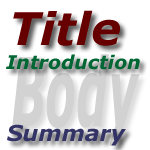 While structured articles may not be appropriate to every blog, the vast majority of blogs will undoubtedly benefit from having a definite article structure, easing readability, improving general reader engagement and even helping you during the writing process.
While structured articles may not be appropriate to every blog, the vast majority of blogs will undoubtedly benefit from having a definite article structure, easing readability, improving general reader engagement and even helping you during the writing process.
Writing a blog post or web article is not that dissimilar to writing any other sort of article, and as such many of the same writing principles remain. To communicate your thoughts in cohesive and coherent fashion, and capture the reader’s attention, your articles really need to follow a defined structure. A good article structure will help readability and enable you to get your point across better.
Having a defined structure to your articles not only benefits your readers, but also greatly helps during the writing phase; helping you to organise and collate your thoughts into a logical structure and hopefully prevent you from rambling too much or veering off topic.
Introduction Section
All articles should begin with some form of introduction to capture the reader’s attention and give them a bit of a clue as to what the whole thing is about.
Title
The first and most important part of the introduction is the article’s title or headline. This should be short and snappy, grabbing the reader’s attention, whilst also giving them a good indication of what the article’s all about.
RSS Summary
If your blog provides an RSS feed in partial format, then the RSS summary is the next stage of the introduction section to consider. A one line summary of the article is probably the best option for this, again aimed at quickly grabbing the reader’s attention, enticing them to read the rest of the article.
Teaser Paragraph
Once you’ve managed to grab your reader’s attention and pull them in with your alluring headline, then the first paragraph, or teaser paragraph is probably the most important paragraph of all. This paragraph gives the reader a brief summary of the whole article, encouraging them to continue reading the rest of the article.
The teaser paragraph may also be used by certain websites as a summary of your article, or be used by some software to automatically generate an RSS summary, and as such is extremely important. Having this paragraph in bold can also serve to highlight it’s importance and draw the reader’s attention.
Introduction
Additional introductory paragraphs serve to further outline the article in more detail, giving the reader a good understanding of what the article is all about and what they can expect to get from the article.
Body
The body of the article is where you develop your central theme and explain your thoughts and ideas in detail. This section should form the majority of your article and follow on from the introduction with a clear and definite structure.
Headings and Sub-headings
Headings and sub-headings should be used to give structure to the body of the article, highlighting the key points being covered, whilst also serving to break up long, monotonous blocks of text.
Paragraphs
In general paragraphs should be kept short to enhance readability, but long enough to present an idea or develop a theme. Long paragraphs should be broken up into logical chunks with subsequent paragraphs continuing the theme.
One line paragraphs should be used sparingly and only for special effect.
Lists can also be considered as a form of paragraph and as such should not be too long as they will loose their impact. Lists are also a very useful way of summarising key points in a quick and easily digestible fashion.
Images can help to enhance the body of the text and explain complex ideas (a picture speaks a thousand words), but should be placed close to the text that they relate to.
As attention spans are not what they used to be (particularly on the web), articles should not be too long, but should focus on a single, primary topic. If while writing the article you get verbal diarrhoea, it may be worth considering splitting the article into separate sections and creating a series related articles instead.
Summary
The summary, or conclusion of the article reiterates the main points of the article in a simple overview, refreshing the points covered in the body and drawing any key conclusions from the discussions.
So, in conclusion, following a definite structure can help you to get your thoughts down in a coherent and logical format, which not only helps you during the writing process, but will also pay dividends improving readability, enabling you to get your point across better and generally increasing reader engagement.
A good, general structure suitable for blog articles is:
- Title / Headline (short and snappy)
- RSS Summary (1 line)
- Teaser Paragraph (single summary paragraph, in bold)
- Introduction (outline of the article)
- Body (the nitty gritty of the article)
- Summary / Conclusion (conclusions and overall summary)

Leave a Reply